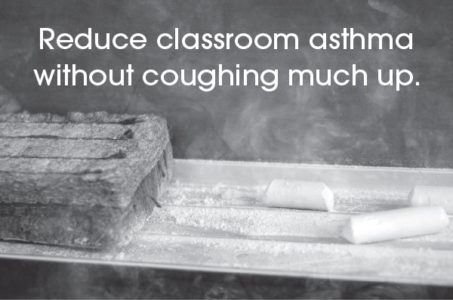
Providing the Best Learning and Breathing Environments
Blog, News & Events
By ipdesign Posted October 1, 2013
In the last year, more than 50% of the 7.1 million child age asthma sufferers experienced severe attacks, resulting in over 14 million combined missed school days. According to the American Academy of Allergy Asthma & Immunology (AAAAI), almost 200 children die each year of complications from these attacks. With such an astounding number of our children at risk, the extreme budget cuts that many school systems in America have made are all the more devastating. The use of state funding to fatten government coffers instead of improving the conditions of our classrooms may be a fatal mistake for some.
Take the Philadelphia School District for example. Philadelphia is the 11th largest school district in the U.S., where roughly 10% of the 178,241 students suffer from asthma. This year, the district closed 24 schools and furloughed more than 3,000 staffers due to the budget crisis. City Council President Darrell Clarke came out in opposition of allocating the estimated $120 million in revenue from an extension of a 1 percent local sales tax to the floundering school system. Instead he proposed sending only $70 million to the schools, and using the remaining $50 million dollars to the city’s underfunded pension system. “If we don’t fix our local pension problem, we are going to be looking at the School District of Philadelphia type of scenario for the city of Philadelphia,” expressed Clarke. “We’re going to have a real problem in a very, very foreseeable future.”
Understandably, government workers are concerned about their retirements. They have spent their careers in service to the City of Philadelphia, and rightly expect compensation. However, the estimated $60 billion spent yearly on asthma related hospitalizations and missed school days places such a burden on families and tax payers alike that it seems only logical to address this health crisis first. The savings to the tax payers in Philadelphia could greatly off set the pension crisis and improve the lives of the city’s most valuable asset, its children.
The major cause of school related asthma attacks is airborne particles. The number one airborne irritant in the school environment is chalk. Chalkboards account for more than 90% percent of the writing surfaces in use in the Philadelphia School System, as well as other challenged urban districts. The cost of resurfacing or replacing the chalkboards with whiteboards is minimal, with the average elementary school being made entirely chalk free for less than $5,000. Following this formula, the entire district could be chalk-free for less than $2 million, a fraction of the medical costs associated with child age asthma, and not even a blip on the budget radar.
As parents, teachers, and more importantly, as civil servants, it is our moral obligation to provide the best possible learning and breathing environments for our children. If this means we tighten our belts at the end of our lives so that those at the beginning of theirs will have a brighter, healthier future, then so be it. And with today’s chalkboard resurfacing technology being so affordable, that bright, healthy tomorrow is there for all of us to share.
